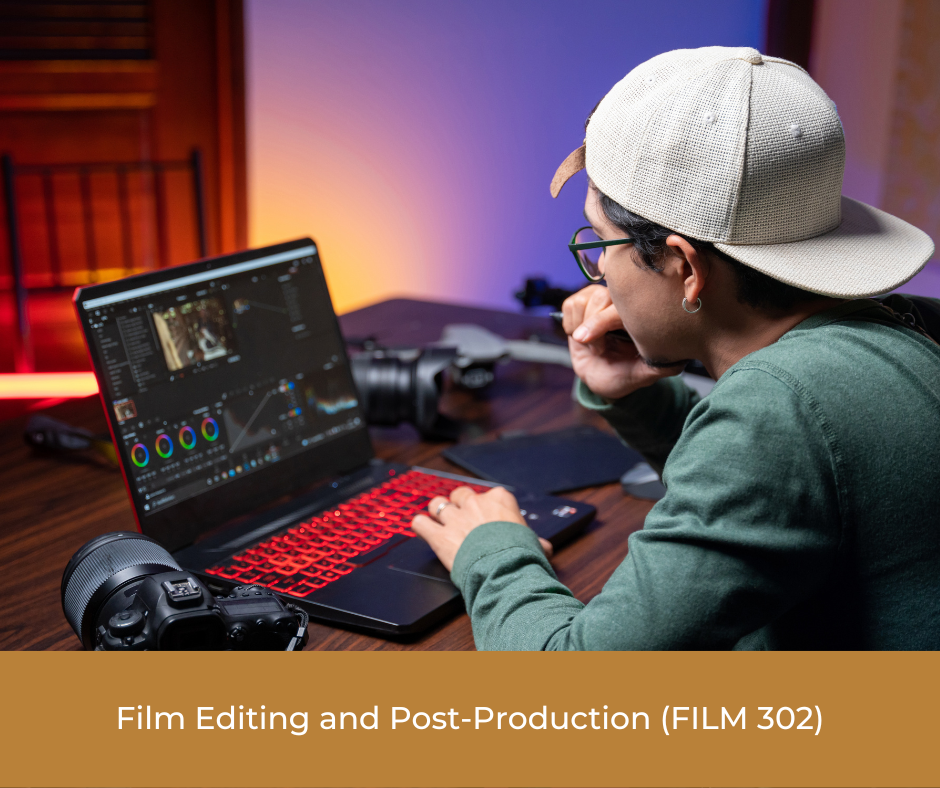Your cart is currently empty!
Film Editing and Post-Production (FILM 302)

“FILM 302: Film Editing and Post-Production” is a comprehensive course that immerses students in the world of post-production in filmmaking. This course explores the critical processes of video editing, sound design, and visual effects, using industry-standard software and techniques to transform raw footage into a polished cinematic work.
Outline of Major Content Areas:
- Introduction to Post-Production: An overview of the post-production phase and its significance in the filmmaking process.
- Video Editing: In-depth exploration of video editing principles and techniques using industry-standard software.
- Sound Design: Understanding the role of sound in film, including dialogue editing, sound effects, Foley, and ambience sound.
- Visual Effects (VFX): Introduction to visual effects and compositing, with a focus on creating seamless and impactful VFX shots.
- Color Grading: Techniques for enhancing the visual aesthetics of a film through color correction and grading.
- Editing Workflows: Developing efficient post-production workflows and best practices for collaboration with other departments.
- Editing for Narrative: Analyzing the relationship between editing choices and storytelling, including pacing, continuity, and emotional impact.
- Audio Post-Production: In-depth exploration of sound mixing, including dialogue, music, and sound effects, to create a balanced and immersive audio experience.
- Visual Effects Integration: Integrating visual effects seamlessly into the film, including green screen compositing and CGI integration.
Course Learning Outcomes:
By the end of FILM 302, students will:
- Proficiency in Editing: Demonstrate proficiency in video editing using industry-standard software, including the ability to assemble and refine a film.
- Sound Design Skills: Develop sound design skills, including the creation of synchronized and immersive audio elements such as dialogue, sound effects, Foley, and ambience sound.
- Visual Effects Knowledge: Acquire knowledge of visual effects principles and techniques, including compositing and CGI integration.
- Color Grading Expertise: Gain expertise in color correction and grading techniques to enhance the visual aesthetics of a film.
- Narrative Understanding: Understand the relationship between editing choices and storytelling, including pacing, continuity, and emotional impact.
- Collaboration Skills: Collaborate effectively with other post-production departments and understand the importance of efficient workflows.
- Audio Post-Production Mastery: Master audio post-production, including sound mixing and creating a balanced and immersive audio experience.
- Visual Effects Integration: Integrate visual effects seamlessly into the film, achieving a high level of realism and visual impact.
Methods for Assessing Student Learning:
Student assessment in FILM 302 will include the following methods:
- Editing Projects: Evaluation of students’ video editing projects, assessing their proficiency in assembling and refining a film.
- Sound Design Assignments: Assessment of sound design assignments, including dialogue editing, sound effects, Foley, and ambience sound.
- Visual Effects Projects: Evaluation of visual effects projects, including compositing and CGI integration.
- Color Grading Exercises: Assessment of color grading exercises, measuring students’ ability to enhance visual aesthetics.
- Narrative Analysis: Analysis of students’ understanding of narrative editing choices and their impact on storytelling.
- Collaborative Work: Assessment of students’ ability to collaborate effectively in post-production workflows.
FILM 302 equips students with the technical and creative skills required to excel in the post-production phase of filmmaking, preparing them to contribute significantly to the final quality of cinematic works.